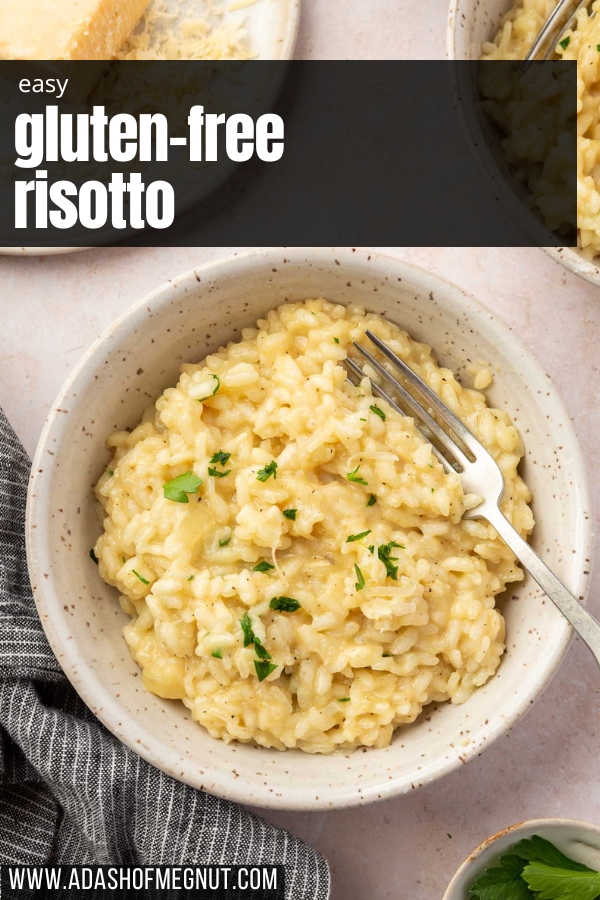
Why this recipe works
This gluten-free risotto recipe brings the essence of Italian comfort food right to your kitchen, creating a dish that’s not only incredibly creamy but also deeply satisfying with every bite. Making risotto at home is quite simple, though it does require quite a bit of stirring over a 20 minute period. I suggest pulling up a stool and a glass of wine while you stir!
Risotto is a great recipe for a cozy evening at home or an elegant dinner party centerpiece. You can add your favorite proteins, like shrimp, chicken, steak, or even my butter poached lobster.
Other additions, like lemon, asparagus or peas are also welcome additions, in which case you’ll love my pea and asparagus risotto with burrata. If mushrooms are your thing, maybe my pumpkin mushroom risotto is a good choice for you! No matter which way you choose to serve your risotto, it’s sure to become a favorite gluten-free meal in your house!
You may be thinking, “isn’t risotto already gluten-free?” It is! While risotto is typically naturally gluten-free, there are a few things you will need to look for to ensure that yours is gluten-free before eating. Look through all of my ingredient notes and tips to make sure that you can make your risotto gluten-free, too!
You’ll love this recipe because:
Ingredients

Ingredient Notes
- Vegetable broth (or chicken broth) – Vegetable broth makes it vegetarian-friendly, while chicken broth adds a deeper flavor for those who prefer it. Be sure that your broth is gluten-free if needed.
- Extra virgin olive oil – Opt for a good quality extra virgin olive oil for sautéing as it adds a subtle fruity flavor to the risotto. You can also use butter for a richer taste.
- Yellow onion – Look for firm, yellow onions with dry, papery skins. They add a slightly sweet and aromatic flavor. You can use a sweet onion or white onion instead if you have those on hand. Shallots can also be a good substitute for a milder taste.
- Garlic – Fresh garlic cloves are best for the most potent flavor. If necessary, you can use 1/2 teaspoon of garlic powder as a substitute for each clove, but fresh is preferred for depth of flavor.
- Dry white wine – Choose a wine that you enjoy drinking. The wine adds acidity and depth to the risotto. If you prefer not to use alcohol, you can substitute with additional broth, but you might miss out on some complexity. I like sauvignon blanc, pinot noir or pinot grigio. Sometimes I’ll even use a really dry riesling since that’s one of my favorites to drink and I always have it on hand.
- Arborio or Carnaroli rice – These specific types of rice are ideal for risotto due to their high starch content, which contributes to the creamy texture. Do not rinse if you want to preserve as much starch as possible.
- Parmesan cheese – Freshly grated Parmesan cheese melts better and provides a fresher, more intense flavor than pre-grated. For a vegan version, look for a suitable plant-based alternative. I like Follow Your Heart Dairy-Free Parmesan Style Shreds.
- Kosher salt – Start with a little and adjust to taste, especially if your broth is already salted.
- Ground black pepper – Freshly ground black pepper offers the best flavor. Adjust the amount based on your preference.
- Fresh parsley – Choose fresh, bright green parsley for garnishing. It adds a fresh, herbaceous note to the dish. I used Italian flat-leaf parsley, but you can also use curly parsley if you prefer.

When preparing risotto, a crucial tip is to warm your broth in a separate pot and keep it simmering gently on the stove before and during the process of adding it to the rice. This ensures that the liquid added to the risotto is always hot, which helps maintain a consistent cooking temperature.
Step-by-Step instructions
While gluten free risotto takes some hands-on time to make stirring it over the stove, the ingredients are few and the actions are so simple! You’ll have a delicious dinner on the table in no time! The below steps with matching photos are not meant to be the full recipe, but are there to help you see the recipe at various stages so you can make risotto at home perfectly every time!
For the ingredient list with measurements, full instructions, printable recipe, and additional notes, please scroll down to the recipe card.










Recipe FAQs
es, risotto is naturally gluten-free as it is primarily made with rice, specifically Arborio or Carnaroli rice, which are all gluten-free grains. The basic ingredients of risotto, such as olive oil, onions, garlic, wine, and Parmesan cheese, are also gluten-free. However, be sure to make sure that your broth is gluten-free as sometimes gluten is added to broth. As always, check all ingredients to ensure they are gluten-free or do not have cross contact with gluten in the manufacturing process.
Risotto requires short-grain rice varieties like Arborio or Carnaroli due to their high amylopectin (a type of starch) content, which contributes to the creamy texture of the dish. Long-grain rices, such as basmati or jasmine, are not suitable as they have different textures and starch content. I typically use Arborio rice in my risotto.
es, you can make risotto in the instant pot. It is less hands on, which I love! Follow the directions on my instant pot lemon risotto recipe.
Yes, you can make this recipe dairy-free and vegan by using vegan parmesan cheese in place of the regular parmesan. I like the Follow Your Heart parmesan brand for vegan parmesan.
Leftover risotto can be reheated gently with a splash of broth or water to loosen it up, as it tends to thicken in the fridge. Stir continuously over low heat until heated through and creamy again.
expert tips
Storage instructions
- Storage: Risotto is best enjoyed fresh, but if you have leftovers, they can be stored in an airtight container in the refrigerator for up to 2-3 days.
- Reheat: To reheat risotto and restore its creamy texture, add it to a saucepan over low heat. Stir in a little broth — start with a few tablespoons and add more as needed. Warm the risotto slowly, stirring frequently until it’s heated through and creamy again. This process may not completely restore the original texture, but it will make the risotto enjoyable. Microwaving is another option, though be sure to cover the risotto and stir periodically, adding a bit of liquid as necessary to prevent it from drying out.

More gluten-free dinners to try
Did you make this recipe?
I’d love to know! Please rate it and leave a comment below. You can also share your pictures and tag @adashofmegnut on Instagram.

Gluten-Free Risotto
Ingredients
- 6 cups vegetable broth - or chicken broth (1420ml)
- 2 tablespoons extra virgin olive oil - 30ml
- 1 cup yellow onion - finely diced (from 1/2 yellow onion) (125g)
- 3 cloves garlic - minced
- 1/2 cup dry white wine - 120ml
- 2 cups arborio or carnaroli rice - rinsed (360g)
- 1/2 cup freshly grated Parmesan cheese - 30g
- 1/2 teaspoon kosher salt - or to taste
- 1/4 teaspoon ground black pepper - or to taste
- 1 tablespoon fresh parsley
**Use the toggle button above to turn the instruction photos on and off!
Instructions
- Bring broth to a simmer in a medium saucepan.
- Heat olive oil in a large saucepan or dutch oven over medium heat.
- Add the onion, cooking until soft and translucent, about 4-5 minutes.
- Then, stir in the minced garlic and sauté 1 minute longer.
- Pour in the arborio rice and stir the rice until it is coated with the olive oil and onions. Toast the rice for about 2 minutes, stirring frequently.
- Add the dry white wine and let cook for about 2 minutes, until the rice has absorbed the wine. Reduce the heat to medium-low heat.
- Once the vegetable broth is simmering, carefully add 1/2 cup to the rice mixture. Stir continuously with a wooden spoon, until the broth is almost completely absorbed. Keep adding 1/2 cup broth at a time, stirring until almost absorbed before adding the next 1/2 cup. This process of adding the broth will take about 20 minutes in total. The rice should be really creamy, yet still al dente.
- Stir in the grated parmesan cheese. Season with salt, pepper and fresh parsley.Let cook for an additional minute until creamy.
- Portion out into bowls. Serve with additional fresh parsley and parmesan cheese, if desired.
Notes
- If you are gluten-free, be sure to check all ingredient labels to make sure they are gluten-free. Vegetable broth is one to be careful of as some brands do contain gluten. As a reminder, bouillon cubes and better than bouillon are NOT gluten-free!
- Patience is important in this recipe to get a very creamy risotto. Add the broth 1/2 cup at a time, stirring in between until the liquid is just almost absorbed. At that point, it’s time to add more broth. You will want to keep the risotto stirring the whole time. Grab a chair and get comfy.






